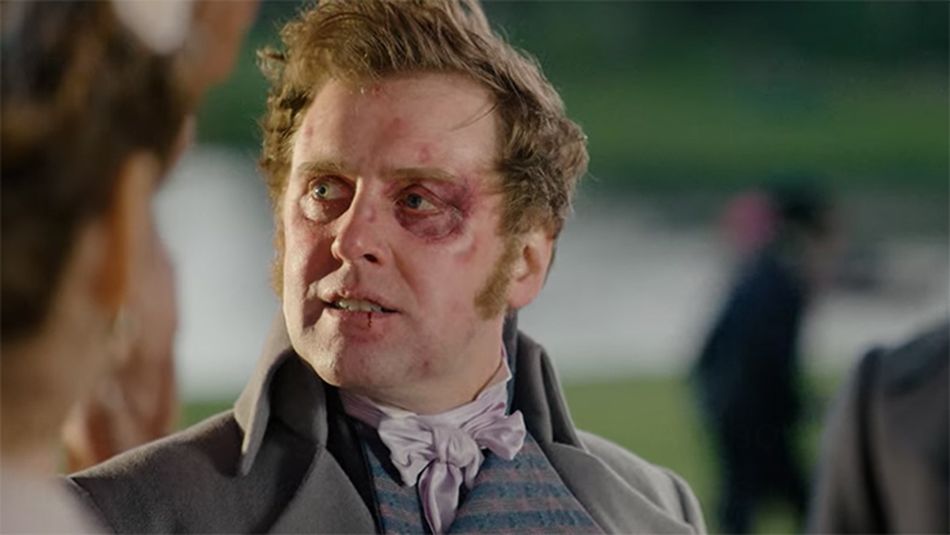Warning: Contains mild spoilers for Season 1, episodes 2 and 3 of Bridgerton.
I’m currently halfway through Season 1 of Bridgerton, and so far I can’t get enough of it.
The costumes, the classical covers of modern songs, the upper-class snark and subterfuge — it’s all great. I binged through the first five episodes in no time at all, and I’ll shortly be binging my way through the rest of it.
But despite how much I’m enjoying Netflix’s latest foray into debutante debauchery, there is one detail that my inner pedant keeps getting stuck on: the boxing matches.
Or rather, one particular aspect of the boxing matches.
I’ll cut straight to the chase: Why is it that whenever the characters are bare knuckle fighting — including regularly, full-on punching each other in the face — nobody comes away with even the slightest blemish?
Look, here’s Anthony Bridgerton (Jonathan Bailey) absolutely leathering the Duke of Hastings (Regé-Jean Page) right in his chiselled jawline.
And here’s the same Duke of Hastings seconds later, casually responding to Anthony’s earlier comment as if that haymaker was nothing more than a casual remark about the weather.
As you can see, he doesn’t have so much as a scratch on him. How is this possible? Is Anthony a really, really terrible puncher? Does the Duke of Hastings, as visual evidence would suggest, boast steel-carved cheekbones?
Well, no, because pretty much every other character on screen apparently possesses the exact same ability. In the boxing match in episode 3, for instance, both the fighters frequently batter each other in the head with absolutely zero signs of bloodshed.
You may be thinking, of course, that Bridgerton is a period drama. It’s not real life. Perhaps the show took the simple decision to take a more comic book-style approach to its violence, where the sound effects are painful but blood isn’t constantly spattering around everywhere?
Well, maybe, but it’s worth noting that not all the characters are completely immune. Here’s Nigel Berbrooke (Jamie Beamish), for instance, the day after he makes the mistake of insulting the Duke of Hastings and takes a thorough pounding for his troubles.

This is what someone would normally look like after being repeatedly punched in the face.
Image: screenshot: netflix
So the question is, why don’t all the characters end up like this after they’ve been pummelling one another? Was it simply a case of the showrunners not wanting their main heartthrobs wandering around bruised all the time? And why are the characters always boxing each other without gloves on, anyway?
Well, it turns out that last point is one of accuracy. Warwick University’s deputy head of the Department of History, Sarah Richardson, confirmed to Mashable that prize fighting was indeed at its height in the early nineteenth century, when Bridgerton is set — but boxing gloves weren’t introduced until much later on.
“Jack Broughton, a famous 18th century prize fighter, introduced some ‘rules’ into bare knuckle fights to try and mitigate extreme violence (thus spitting, scratching, and hitting ‘below the belt’ were outlawed),” she explained. “He also advocated bandaging or padding hands for training but part of the attraction of prize fights was the violence and it was not until the Marquess of Queensberry reformed the sport in 1867 that gloves were used for match fights.”

‘Absolute tank’ — not the title John Hamilton Mortimer would have used for his portrait of Jack Broughton, ca. 1767.
Image: Sepia Times / Universal Images Group via Getty Images
In 1813, when Bridgerton is set, bare knuckle boxing was a big source of gambling that had been popularised among the upper classes by the likes of Lord Byron, meaning the fights in the show (injuries aside) are probably fairly true to what life was like back then.
And as for the decision to leave off the blood and bruises? If we had to guess, it’s probably all to do with aesthetics — but we’ve reached out to Shondaland, the production company behind Bridgerton, with some additional questions. We’ll update this article when we hear back.
Meanwhile, Bridgerton is now streaming on Netflix.
WATCH: The horniest TV moments from 2020

